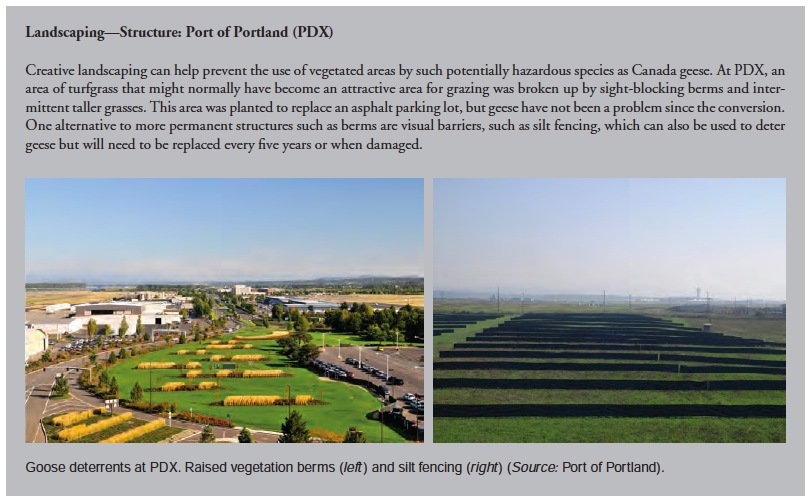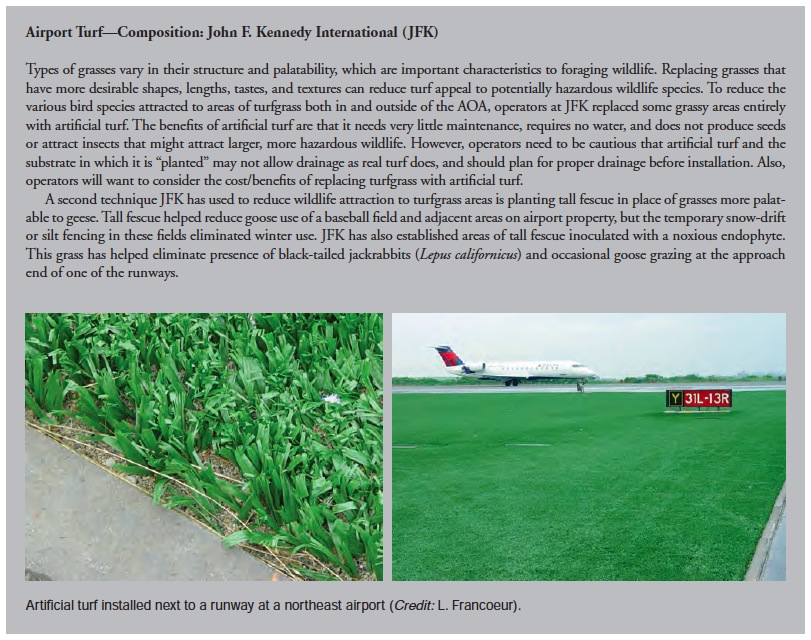AIRPORT COOPERATIVE RESEARCH PROGRAM
All wild animals have basic needs that must be met for them to survive and reproduce, specifically food for nutrition and energy, water for hydration, and shelter (sometimes called cover) for protection from exposure to detrimental weather and predation. Wildlife harness these resources from their natural habitat—the environment around them—but many species will exploit resources in environments that have been heavily manipulated by people, even extremely urban areas such as cities and industrial facilities. Airports are human-dominated landscapes, but are often surrounded by or adjacent to environments containing resources attractive to wildlife.
Efficient and effective wildlife management is a challenging endeavor in any environment, but the safety concerns and human activities at airports add complexities to any management plan. Many species of wildlife in airport environments are potentially hazardous to aircraft operation safety; those most hazardous at a particular airport will depend on the specific location and array of attractants, such as water and certain vegetation, whether naturally occurring or not, on and around airport grounds.
Numerous habitat features, including human-made structures that can attract potentially hazardous wildlife, are identified in this synthesis. Also described are some of the management techniques and habitat changes that can be made to decrease the allure of these features to wildlife. This general information is supplemented with examples from the literature and from airports across North America that have directly experienced problems with many of the habitat features described.
Airport operators and wildlife biologists can work together to determine effective measures that will minimize the risks posed by wildlife at an airport, a process that often involves the determination of what initially attracts wildlife to the area. However, while in some cases deterring wildlife from an attractant may be solved with a simple and inexpensive approach, often wildlife will be persistent. Integrating changes to habitat, along with harassment and perhaps even lethal removal of wildlife, may be necessary to solve a problem with potentially hazardous wildlife populations. Also, what deters one species may not discourage another, and an effective technique at one airport may not work as well elsewhere.
Manipulating habitat features is not the only challenge that airport operators face in the process of reducing wildlife attraction to their airport. Airports are also faced with regulations concerning environmental impacts and effects on threatened and endangered species, and pressures to reduce use of fossil fuels and increase use of renewable energies. Operators can work closely with a wildlife biologist to develop a Wildlife Hazard Management Plan (WHMP) that meets their specific needs, and adapt their plans and techniques within legal and environmental constraints.
This synthesis builds on previous ACRP documents, including ACRP Synthesis 23, ACRP Report 32, and ACRP Synthesis 39, which address bird deterrence and harassment techniques, various wildlife hazards and control techniques, and population management methods, respectively. This synthesis focuses on the elements that entice wildlife to an airport, so that operators can remove or reduce access to the most attractive habitat features. It is based on review and compilation of pertinent literature, and case examples from 17 airports that illustrate how airports are modifying habitats to minimize wildlife risks to aviation.
However, airports are often large parcels of property that are only part of a larger, more complex landscape that should be considered when implementing habitat management. Most airport operators and airport patrons would likely enjoy having an aesthetically pleasing landscape around them as long as safety risks are minimized. This is often possible with appropriate planning, and some airports are using their land to provide conservation areas for wildlife. Safety will remain a primary concern for airport personnel and the general public, and habitat management can be an effective approach to reduce wildlife risk to safe airport operations.
Download full version (PDF): Habitat Management to Deter Wildlife at Airports
About the Airport Cooperative Research Program
www.trb.org/ACRP
“The Airport Cooperative Research Program (ACRP) is an industry-driven, applied research program that develops near-term, practical solutions to problems faced by airport operators. ACRP is managed by the Transportation Research Board (TRB) of the National Academies and sponsored by the Federal Aviation Administration (FAA). The research is conducted by contractors who are selected on the basis of competitive proposals.”
Tags: ACRP, AIRPORT COOPERATIVE RESEARCH PROGRAM, airports, Federal Aviation Administration, Transportation Research Board, TRB








 RSS Feed
RSS Feed